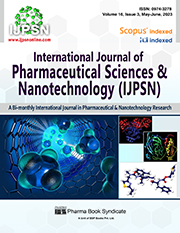Determination of Gabapentin and Rabeprazole in Human Plasma by Using High-Performance Liquid Chromato-graphy and its Application to Therapeutic Drug Monitoring
DOI:
https://doi.org/10.37285/ijpsn.2023.16.3.2Abstract
Background: Gabapentin is an anticonvulsant drug developed to treat epilepsy. In recent years, the use of this medicine has increased in a variety of indications. Rabeprazole, a proton pump inhibitor, is mainly given in combination with gabapentin. The study aims to simultaneously estimate gabapentin and Rabeprazole and to monitor the therapeutic activity of gabapentin in human plasma samples.
Method: To determine the plasma concentration of gabapentin in participants, a bioanalytical method was developed and validated using high-performance liquid chromatography. Forty-two epileptic participants received doses of gabapentin ranging from 100 to 800 mg, and plasma concentrations were examined. The average mean serum concentration for males was 723.64 ng/ml; for females, it was 1770.07 ng/ml.
Results: The concentration of male to female ratio for gabapentin was 71:29 with Rabeprazole as comedication, Total mean serum concentration of levetiracetam from males is 723.64ng/ml and females is 1770.07ng/ml. Welsch ttest was plotted with males and females ranging from 31 to 11 sizes as an unpaired ttest with p=0.0035 (p≤0.05). TDM was still shown to be effective in the majority of patients to support dosage increases and individualization of therapy.
Conclusion: The method proposed for measuring gabapentin concentration was convenient, reproducible, and specific. Only detailed clinical justifications should be used to request TDM and the service should be tailored to the therapeutic indication.
Downloads
Metrics
Keywords:
Gabapentin, Rabeprazole, Therapeutic drug monitoring, method developmentDownloads
Published
How to Cite
Issue
Section
References
Berry DJ, Beran RG, Plunkeft MJ, Clarke LA, Hung WT. The absorption of gabapentin following high dose escalation. Seizure. 2003 Jan 1;12(1):28-36.
Vollmer KO, Von Hodenberg A, Kölle EU. Pharmacokinetics and metabolism of gabapentin in rat, dog and man. Arzneimittel-Forschung. 1986 May 1;36(5):830-9.
Gujral RS, Haque SM. Development and validation of a new HPLC method for the determination of gabapentin. International Journal of Biomedical Science: IJBS. 2009 Mar; 5(1):63.
Dickenson AH, Ghandehari J. Anti-convulsants and anti-depressants. Analgesia. 2007:145-77.
Rogawski MA, Löscher W. The neurobiology of anti-epileptic anti-epileptic drugs for the treatment of nonepileptic conditions. Nature medicine. 2004 Jul;10(7):685-92.
Coderre TJ, Kumar N, Lefebvre CD, Yu JS. A comparison of the glutamate release inhibition and anti‐allodynic effects of gabapentin, lamotrigine, and riluzole in a model of neuropathic pain. Journal of Neurochemistry. 2007 Mar;100(5):1289-99.
Cunningham MO, Woodhall GL, Thompson SE, Dooley DJ, Jones RS. Dual effects of gabapentin and pregabalin on glutamate release at rat entorhinal synapses in vitro. European Journal of Neuroscience. 2004 Sep;20(6):1566-76.
McLean MJ. Gabapentin. Epilepsia. 1995 Feb;36:S73-86.
Wong MO, Eldon MA, Keane WF, Türck D, Bockbrader HN, Underwood BA, Sedman AJ, Halstenson CE. Disposition of gabapentin in anuric subjects on hemodialysis. The Journal of Clinical Pharmacology. 1995 Jun;35(6):622-6.
Sivenius J, Kälviäinen R, Ylinen A, Riekkinen P. Double‐blind study of gabapentin in the treatment of partial seizures. Epilepsia. 1991 Aug;32(4): 539-42.
Armijo JA, Pena MA, Adín J, Vega-Gil N. Association between patient age and gabapentin serum concentration-to-dose ratio: a preliminary multivariate analysis. Therapeutic drug monitoring. 2004 Dec 1;26(6):633-7.
Patsalos PN. Phenobarbitone to gabapentin: a guide to 82 years of anti-epileptic anti-epileptic drug pharmacokinetic interactions. Seizure. 1994 Sep 1;3(3):163-70.
Uno T, Yasui-Furukori N, Shimizu M, Sugawara K, Tateishi T. Determination of Rabeprazole and its active metabolite, rabeprazole thioether in human plasma by column-switching high-performance liquid chromatography and its application to pharmacokinetic study. Journal of Chromatography B. 2005 Sep 25;824(1-2):238-43.
Prakash A, Faulds D. Rabeprazole. Drugs. 1998 Feb;55:261-7.
Williams MP, Pounder RE. The pharmacology of Rabeprazole. Alimentary Pharmacology & Therapeutics. 1999 Aug 1;13:3-10.
Mano N, Oda Y, Takakuwa S, Chiku S, Nakata H, Asakawa N. Plasma direct injection high-performance liquid chromatographic method for simultaneously determining E3810 enantiomers and their metabolites by using flavoprotein-conjugated column. Journal of pharmaceutical sciences. 1996 Sep 1;85(9):903-7.
Ghante MR, Tangade RB, Sawant SD, Kulkarni PD, Bhusari VK. Development and Validation of stability indicating RP-HPLC method for the estimation of Ertugliflozin by forced degradation studies. Research Journal of Pharmacy and Technology. 2022;15(11):4945-9.
Yasuda S, Ohnishi A, Ogawa T, Tomono Y, Hasegawa J, Nakai H, Shimamura Y, Morishita N. Pharmacokinetic properties of E3810, a new proton pump inhibitor, in healthy male volunteers. International Journal of clinical pharmacology and Therapeutics. 1994 Sep 1; 32(9):466-73.






